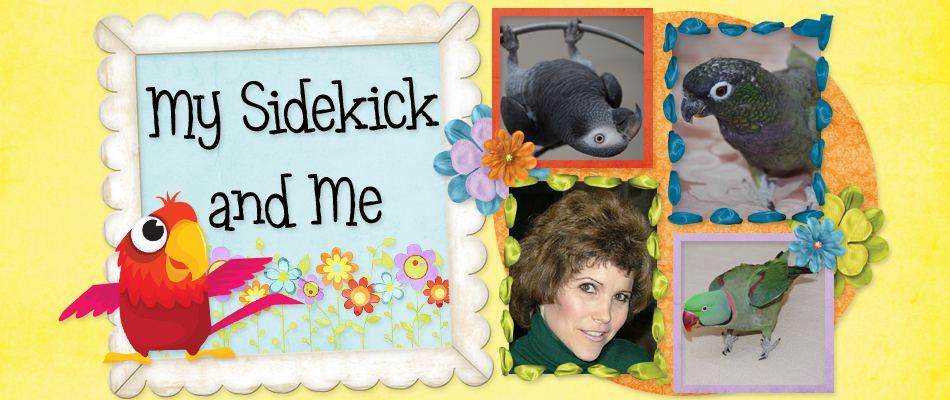In loving memory of my very dear Chester. For the past 18 years, he has filled my home with antics and affection. Always eager to be with me, he'd jump on my arm the minute he saw an opportunity and he'd stay on my shoulder for hours if I let him. He had an uncanny ability to sense when I was down and would huddle close to my neck. We had a very special bond. Chester died in my arms this weekend. I love him and I miss him so much.
Below is a story I had written in 1998 about how Chester came into my life.
Just six months old, his was like the face of a starry eyed child. Innocent, yet devilish, his boyish grin was only a clear mask hiding the mischief that lied within. There he sat, snuggled side-by-side next to his sister more than 100 miles from the only place they had ever known as “home”. Their biological parents were left behind, perhaps never to be seen again.
Dozens of strangers – mammoth Hercules – more than twenty times these young siblings’ size, passed by, sticking out fingers and hands, asking questions. Time and again the little green bird was asked to “step up” onto unfamiliar arms, makeshift perches to him, while being scrutinized like a fine painting in an art gallery.
This was to be the day when Chester would see his sister for the last time, the day when “home” would forever carry different meaning. Yet, as he sat, resting comfortably on one foot, he could only hope his fate would find him in a warm, caring environment. A place where silliness was encouraged and love meant acceptance. A place where he would never need to mature, but remain a perpetual child the rest of his life. And, of course, a place where destroying furniture was only reprimanded with a few harmless words….
The sun had shown especially bright that Sunday morning. Seeming to rush me out of bed like an eager child on his birthday, I suppose in hindsight that the signs were obvious how my life was about to change.
I wasn’t planing on buying another bird. The thought never crossed my mind. My one bedroom apartment was already home to a nanday conure, with a high pitched scream that was about as welcoming a noise as someone scraping his fingernails on a chalk board.
As I prepared to catch up with friends at a local bird show, I just couldn’t ward off that temporary emptiness that follows a wounded heart. Only a few days had passed since a man I cared about had told me he was seeing someone new. There was a void in my life that left me vulnerable, stripped me of my defenses against the iron will of a guileless child. And, it was in that brief moment of weakness that I found pleasure and beauty in the eyes of a gaping six-month-old.
From a distance I could see him. Carefully balanced on one leg, Chester appeared weary from the afternoon’s stress. Yet when I approached something magical happened. His eyes opened wide and his toothpick-sized legs could barely keep up with his heart as he raced to my side. I reached out my arm and he jumped on. I stroked his head and he sat calm, basking in my human touch. And my sadness was suspended in the beauty of unconditional love.
I don’t know what it was that drew him to me that day. I guess it doesn’t really matter. They say animals have an uncanny ability to sense human emotions, and I believe that’s true. I also believe that love is something shared between two souls and that giving also means receiving in matters of the heart. I’m reminded of it every day since Chester came into my life.
Sunday, November 29, 2009
When Two Lives Merge...
Wednesday, November 4, 2009
Positive Behavior Management In Pets

The feedback I received from people with whom I shared bits of that conversation – and the subsequent success I’ve had teaching my parents’ dog, Sam, was my positive reinforcement that has inspired me to want to write more about the subject.
Have you ever read Karen Pryor’s “Don’t Shoot The Dog”? It’s a really great book everyone who shares their home with an animal – including the human kind.
All too often, when a pet has behaved in an unacceptable way, we blame our pet. We assume our pet knows what we want him to do and he’s doing it because he is jealous or obstinate or mad. ‘My dog was mad at me for leaving.’ ‘My bird was jealous of my boyfriend.’ Have you ever made a comment like that? Bet you have. I know I did before I was enlightened.
What Jeni and Susan and others who use positive methods to teach recognize is that blaming or labeling the pet is really not going to be all that helpful in solving the problem. Although it is much easier to put a label on behavior, generally that label stops us in our tracks from working to find a solution. Instead, a much more productive approach is looking at the behavior in terms of what purpose it serves the animal. And, if your pet isn’t doing what you want him to do, it is your role to teach him.
Let me back up a second because this is important. Let’s think about it. Is it really possible to know what your pet is thinking or feeling? I may think my dog is mad or jealous but how can I really know? Heck, I can’t even figure men out. The only thing I do know for sure is that my pet is behaving, and for him to continue to behave in that way, he is being reinforced by something.
As a caretaker, and therefore trainer, I’ve come to realize that I can very effectively empower my pets to make decisions and modify their behavior in a way that will lead to their success while also improving their quality of life.
So, instead of just focusing on removing the problem behavior, now I look at the behavior in terms of ‘what’s in it’ for my pet. Is it possible that Sam stands up with two legs on the kitchen table during meals, not because he’s being bad, but because he learned that if he does, eventually the chances are good that he is either going to get human attention or a piece of something tasty? Or that Barnaby wasn’t stepping up because he knew that based on past experience, stepping up at the end of the night meant no more play time?
How can your pet be accountable for his behavior if you or something else in the environment gave that behavior purpose?
As Sam’s trainer then, I also can predict that when we sit down to eat, if Sam isn’t preoccupied with something else the chances are good he’s going to stand on the table. What are my options? Well, if we wait to feed him until we sit down that will keep him busy and satiated. I can also wrap his favorite bone in a newspaper and then in a sock, an activity that I know will keep his attention. And if all else fails and he comes to the table, I can completely ignore his standing up behavior and calmly tell him to sit. Then when he sits, I reinforce the heck out of it – with a treat AND praise. Life is pretty darned good for him when he chooses to sit by my side instead of jump up. Guess which behavior he will choose to do if I, as his trainer, am consistent in ignoring behavior I want to see less of and reinforcing behavior I want to see more of.
If, on the other hand, I chose to try and solve Sam’s jumping up behavior with punishment like a squirt bottle or a stern NO, do you think it would foster the same eagerness toward learning? Scientific data says no. Personal experience says no. Chances are it will also damage your relationship with your pet who will associate you with the punishment, can create apathy toward learning (that’s when you hear people call their pets dumb), and may even cause aggression.
Applied behavior Analysis is the process of solving practical behavior problems by changing the environment. It involves focusing tightly on the specific behavior you want to modify, and then looking at it in the context of its surroundings. What is giving that behavior purpose? What happened immediately prior to the behavior (antecedent) to set the wheels turning? What happened *immediately* after the behavior to reinforce it (consequence)?
When you look at the behavior in this way, you can begin to think about what needs to change in order to teach your pet what you want it to do. Positive reinforcement is all about arranging very motivating consequences to a behavior that are meaningful to the animal, while making sure you don’t inadvertently reward the wrong behavior. And one of the great perks to this kind of teaching strategy is that you’ll also notice your relationship with your pet grow as it associates you with that reward.
To read more about my behavior conversations with Jeni, please click here.
Sunday, November 1, 2009
Barnaby's personal album
Barnaby's family












